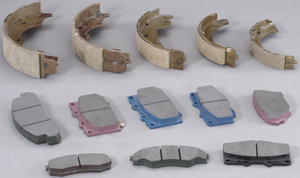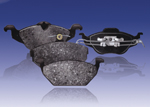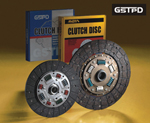Frictional Car Parts Sector in China Seems Unstoppable Amid Speeding Car Sales
2008/04/22 | By CENSThe rising affluence in mainland China has been fueling the accelerating growth of its automobile market in recent years, driving the annual sale of new cars to 8.3 million units in 2007, up 16.3% from the previous year, according to statistics compiled by the National Bureau of Statistics of China (NBSC).

By the end of 2007, statistics show that private car ownership in China topped 56.97 million units (including 14.68 million tri-wheeled vehicles and low-speed light trucks), a 143% increase from the previous year.
As a car market grows, so do its support products and services. And most insiders know that, especially in emerging markets where drivers are less sophisticated in terms of using techniques to prolong life of car parts, where stop-and-go traffic is part and parcel to the relatively new development of car ownership-frictional parts as brake shoes, pads, and clutch plates are major replacement items. And the numbers seem to confirm such phenomenon: China's domestic frictional car parts segment has been growing at an annual average of 30%, which is also compounded by the rapidly rising car sales in a market that is predicted to have the potential to soon exceed in size to even that stateside.
Major Production Bases: Shandong, Zhejiang & Guangdong
Most major makers of brake shoes and pads in China are clustered in Shandong, Zhejiang, Guangdong, Fujian, Hubei, and Hebei provinces. However, most industry experts would agree that a more realistic estimate of the major brake shoe/pad manufacturers in China totals about 50.

Following the normal developmental path of any emerging industrial sector, the big usually get stronger and even bigger, while the smaller tend to flounder in the competition and end up being reduced in size and marginalized. Such scenario is seen to be inevitable and necessary as the smaller operators are weeded out. One factor setting up such development is capacity to achieve economy of scale, where bigger outfits clearly have cost advantages, higher production efficiencies over their smaller rivals. To both buyer and supplier, this trend is seen as positive as the market is gradually upgraded as amateurish and fly-by-night makers are beaten and screened out.
Driving Towards Non-Asbestos
Unsurprisingly and for a long time, brake pad and shoe makers in China have stuck to the path-of-least-resistance in an economy where usually cheap is best, which tends to discourage R&D. This resulted in that China's makers of frictional car parts had been using age-old material formulae: They adopt the cheapest and most readily-available stock-asbestos-to turn out brake shoes and pads. The problem is that asbestos parts offer not only lackluster performance relative to their more modern metallic and even ceramic composites, but are also carcinogenic. Incidentally, asbestos is softer than ceramic, Kevlar, and other metallic composites and hence tends to wear out faster. Moreover and as the global automotive industry also becomes more green sensitive, the health-hazardous asbestos is being gradually banned as a frictional brake material.

Despite the speedy growth of the car market in China, most non-asbestos materials for frictional brake parts in China are still imported. So one of the most urgent missions for the car parts sector in China is to upgrade its self-content capacity, or produce locally parts needed for its burgeoning car sector. In this case, the makers of frictional brake parts in China need to quickly develop the capacity to produce independently non-asbestos brake parts.
Clearly a dilemma exists: the existing national standards in China allow makers to produce asbestos-content frictional brake parts, yet the majority of such exports are of non-asbestos materials. One suspects that cost, technical and human factors are at work to allow Chinese makers to continue to use asbestos. Currently, frictional brake parts makers in China use about 30,000 tons of asbestos annually.
Ceramic Stops Better
One of the newest, advanced frictional brake materials developed in the sector globally is ceramic composites. This super-hard material is superior to asbestos in terms of reduced noise, superior wear and hence minimized dust, better fade resistance etc.
Showing a degree of industrial upgrading, some major players in China have the in-house capacity to produce advanced frictional brake parts, supplying such items to automakers in China as well as other nations.
Shandong Gold Phoenix Group Corp., for example, successfully developed its homegrown ceramic frictional material in 2004. After winning reassuring feedback from overseas markets to which it exported advanced frictional brake parts, Shandong Gold Phoenix then was chosen by many automakers in China as an original equipment (OE) frictional brake parts supplier.
Some hurdles lie in the way of further popularizing the use of ceramic frictional brake parts in China, one of which is its relatively high price, which is still unacceptable by automakers in China who are trying to minimize costs amid fierce competition. While ceramic frictional brake parts are widely welcome in advanced nations for their performance advantages over traditional counterparts, drivers in China have yet to catch up to their western counterparts in terms of sophistication-deprioritizing such characteristics as low noise, high durability and eco-friendliness. Most likely that the majority of drivers in China, while demanding safety and performance, are not adequately well-informed or are indifferent with respect to the finer aspects of advanced frictional brake parts.
Currently, there are a handful of major players in China's frictional car parts sector who may be capable of building items measuring up to world-class standards, and their names follow:
1.Shandong Gold Phoenix Group Corporation
2. Hangzhou Hangcheng Friction Material Co., Ltd.
3.Hangzhou Westlake Friction Meterial Co., Ltd.
4.Shandong Double Link Brake Material Co., Ltd.
5.Shandong Xinyi Group
6.Hubei Feilong Friction Materials Co., Ltd.
7.Guanlean Automotive Parts Industry (Fujian) Co., Ltd.
8.Zaoyang Xingya Friction Material Co.,
9.Hebei Xingyue Braking Element Co., Ltd.
10.Lucky Industry Development Co., Ltd.
11.Hengshui Zhongcheng Frictional Material Co. Ltd.
12.China Laizhou Luda Brake Friction Co., Ltd.
13.Hebei Fuao Auto Parts Co., Ltd.
14.Hangwan Automobile Spare Parts Industrial Corporation Co., Ltd.
15.Wuhu Zhongya Car Brake Parts Co., Ltd.
16.Jiangsu Veectory Group Co., Ltd.
17.Shanghai Lecabrake Products Co., Ltd.
18.Hangzhou Yuhang Feiying Eagle Friction Material Co., Ltd.
19.Taizhou Hualong Clutch Co., Ltd.
20.Hunan Changde Jida Friction Material Co., Ltd.




